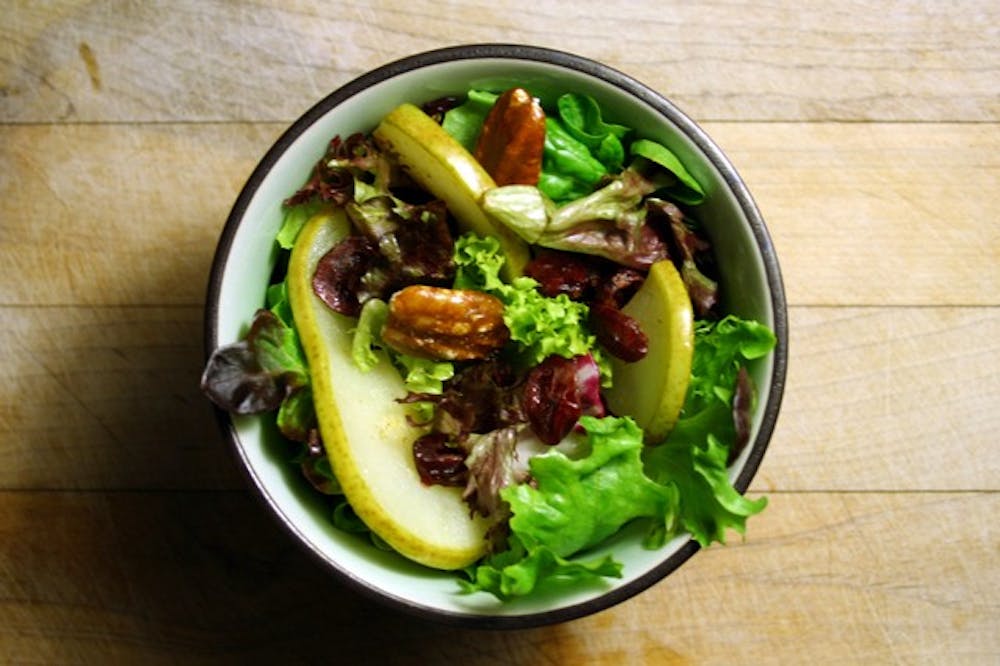
The hyper-healthy culture at Penn is cultivated by surrounding restaurants like Magic Carpet and SweetGreen. The love for healthy food is especially seen through the students' penchant towards salads. | Courtesy of TheDeliciousLife/Creative Commons
If you attempt to grab a quick salad for lunch at Penn, you’ll have a lot of choices: HipCityVeg, Saladworks and Sweetgreen, just to name a few. Penn is surrounded with healthy options, and the line at Magic Carpet at noon on any given day expresses how much Penn loves healthy eating.
Aren’t college kids supposed to be unhealthy? The “normal” college student who appears in popular culture binge eats pizza, ramen and copious amounts of dining hall food — where else would the “Freshman 15” come from? At Penn, students actually seem concerned with what they are putting into their bodies.
Philadelphia isn’t traditionally associated with healthy food. Cheesesteaks and soft pretzels do not make for a gym-ready body. But there seems to be a recent push in health in the Philadelphia area, increasingly known for its brand-name chef restaurants. Campus has seen the addition of Pure Fare in Houston Hall and will soon see the opening of veggie-centric Beefsteak in the same building, and Honeygrow on Walnut. On Sunday, Philadelphia Magazine published an article about 11 new fitness and healthy eating restaurants opening downtown in the fall alone.
But these same standards might not be true at other Philadelphia universities. Temple University student Libby Atterbury sees a food landscape more accepting of fast food restaurants at her school.
“People from Temple were happy we got a Burger King. There’s a lot of crappy Chinese places that have walk-up windows, McDonalds, Wendy’s ... because they are cheap,” she said.
Atterbury’s older sister went to Penn, so she is familiar with both college campuses.
“Penn is different because of its socioeconomic status,” Atterbury said. “University City is like its own hub. You have Drexel and Penn on the same campus, and a lot of professors living in University City, as well as a large crowd from HUP.”
Atterbury believes this is a result of the type of people that both areas of Philadelphia attract. She assumes that University City brings a higher economic bracket than Temple’s campus, especially since the surrounding areas are filled with hospitals and their staff.
Other Ivy League schools boast similar restaurants to Penn’s, possibly due to similar socioeconomic reasons. Harvard University has a few sushi bars, and even a place called Harvest. But they have more than a few burger places as well, including Danny Meyer’s Shake Shack.
So-called Ivy League prestige might play less of a role in the healthy food industry’s choice to develop at Penn than its metropolitan location. For example, George Washington University’s main housing in Washington, D.C. is two streets away from a Whole Foods and a Sweetgreen, which was started in the city. Cambridge is home to two of the country’s top universities, but is also the fifth most populous city in Massachusetts. Stanford, located in Silicon Valley, was voted peta2’s favorite vegan-friendly college in its 2015 bracket (Penn was knocked out the second round).
Lakshmi Sivaguru is a 2013 College graduate; she explained how the scene at Penn has been changing and evolving throughout the years.
“Healthy options were pretty limited my freshman year,” Sivaguru said. She said the main healthy food restaurants were Hummus and Gia Pronto; Magic Carpet “had a cult following before I was a freshman.” SweetGreen opened Sivaguru’s junior year, and their salads became very popular after that, taking over the role of Gia Pronto, which has changed its name to Kitchen Gia.
At least seven food vendors within a block of Penn’s campus market themselves as healthy, farm-to-table and/or vegetarian food options. This number will become at least nine with the opening of Honeygrow and Beefsteak.
The Daily Pennsylvanian is an independent, student-run newspaper. Please consider making a donation to support the coverage that shapes the University. Your generosity ensures a future of strong journalism at Penn.
DonatePlease note All comments are eligible for publication in The Daily Pennsylvanian.







